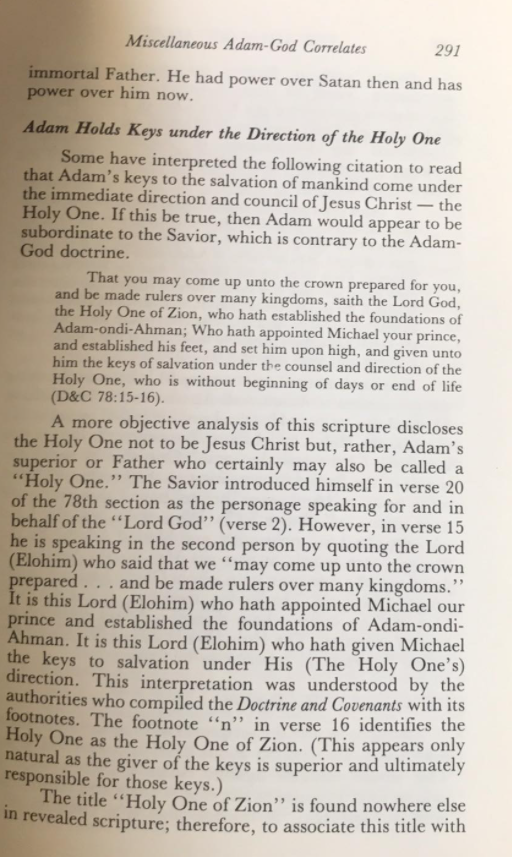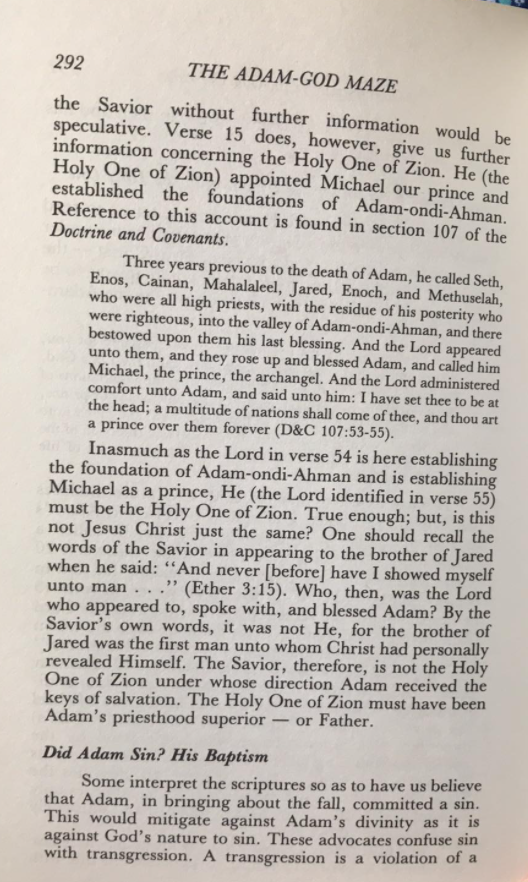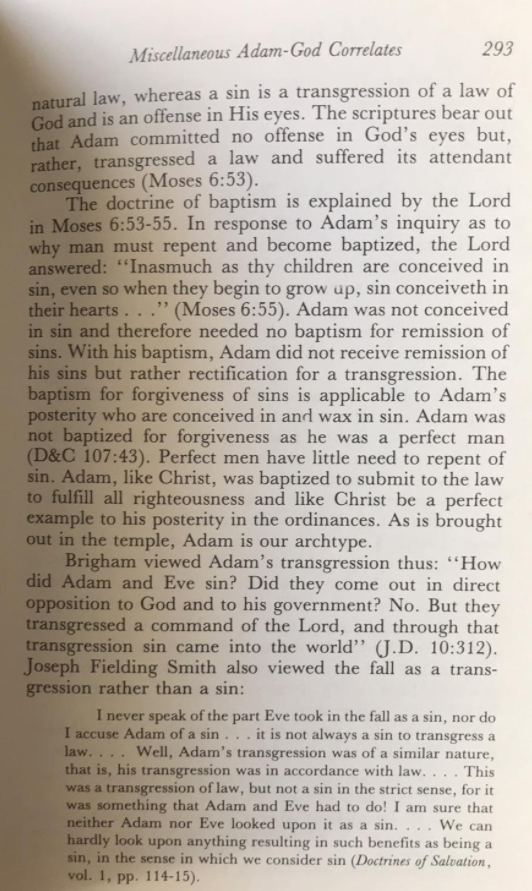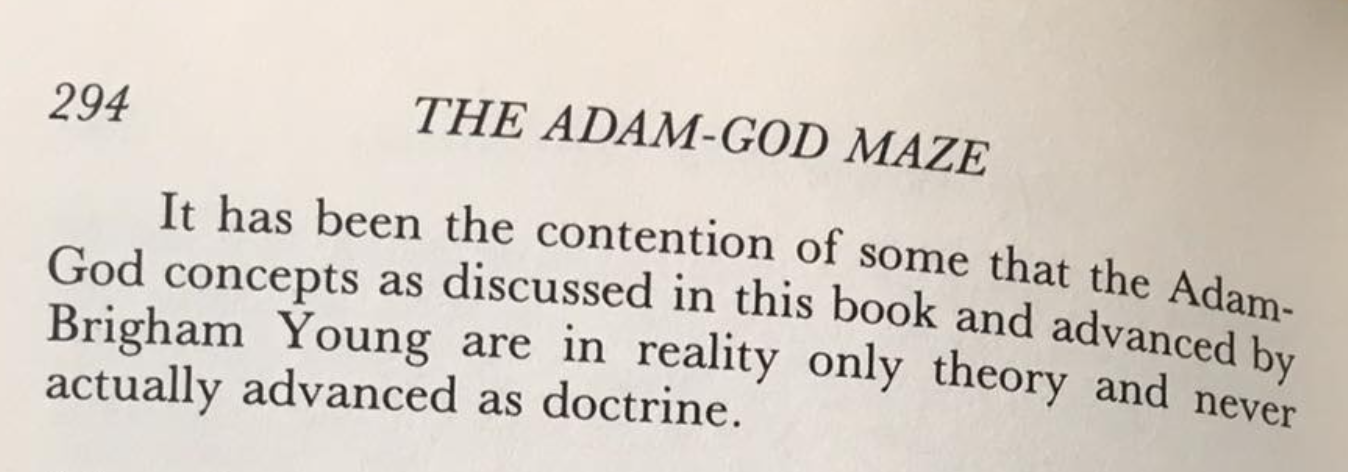Culley K. Christensen defends belief in Adam-God doctrine in light of the Adam being baptized in LDS Scripture.
- Type
- Book
- Source
- Culley K. Christensen
- Hearsay
- Direct
- Reference
Culley K. Christensen, The Adam-God Maze (Scottsdale, Arizona: Independent Publishers, 1981), 291-94
- Scribe/Publisher
- Independent Publishers
- Audience
- Reading Public
- Transcription
Adam Holds Keys under the Direction of the Holy One
Some have interpreted the following citation to read that Adam’s keys to the salvation of mankind come under the immediate direction and council of Jesus Christ—the Holy One. If this be true, then Adam would appear to be subordinate to the Savior, which is contrary to the Adam-God doctrine.
That you may come up into the crown prepared for you, and be made rulers over many kingdoms, saith the Lord God, the Holy One of Zion, who hath established the foundations of Adam-ondi-Ahman; Who hath appointed Michael your prince, and established his feet, and set him upon high, and given unto him the keys of salvation under the counsel and direction of the Holy One, who is without beginning of days or end of life (D&C 78:15-16).
A more objective analysis of this scripture discloses the Holy One not to be Jesus Christ but, rather, Adam’s superior or Father who certainly may also be called a “holy One.” The Savior introduced himself in verse 20 of the 78th section as the personage speaking for and in behalf of the “Lord God” (verse 2). However, in verse 15 he is speaking in the second person by quoting the Lord (Elohim) who said that we “may come up unto the crown prepared . . . and be made rulers over many kingdoms.” It is this Lord (Elohim) who hath given Michael the keys to salvation under His (The Holy One’s) direction. This interpretation was understood by the authorities who compiled the Doctrine and Covenants with its footnotes. The footnote “n” in verse 16 identifies the Holy One as the Holy One of Zion. (This appears only natural as the giver of the keys is superior and ultimately responsible for those keys.)
The title “Holy One of Zion” is found nowhere else in revealed scripture; therefore, to associate the title with the Savior without further information would be speculative. Verse 15 does, however, give us further information concerning the Holy One of Zion. He (the Holy One of Zion) appointed Michael our prince and established the foundations of Adam-ondi-Ahman. Reference to this account is found in section 107 of the Doctrine and Covenants.
Three years previous to the death of Adam, he called Seth, Enos, Cainan, Mahalaleel, Jared, Enoch, and Methuselah, who were all high priests, with the residue of his posterity who were righteous, into the valley of Adam-ondi-Ahman, and there bestowed upon them his last blessing. And the Lord appeared unto them, and they rose up and blessed Adam, and called him Michael, the prince, the archangel. And the Lord administered comfort unto Adam, and said unto him: I have set thee to be at the head; a multitude of nations shall come of thee, and thou art a prince over them forever (D&C 107:53-54)
Inasmuch as the Lord in verse 54 is here establishing the foundation of Adam-ondi-Ahman and is establishing Michael as a prince, He (the Lord identified in verse 55) must be the Holy One of Zion. True enough; but, is this not Jesus Christ just the same? One should recall the words of the Savior in appearing to the brother of Jared when he said: “And never [before] have I showed myself unto man . . . “ (Ether 3:15). Who, then, was the Lord who appeared to, spoke with, and blessed Adam? By the Savior’s own words, it was not He, for the brother of Jared was the first man unto whom Christ had personally revealed Himself. The Savior, therefore, is not the Holy One of Zion under whose direction Adam received the keys of salvation. The Holy One of Zion must have been Adam’s priesthood superior—or Father.
Did Adam Sin? His Baptism
Some interpret the scriptures so as to have us believe that Adam, in bringing about the fall, committed a sin. This would mitigate against Adam’s divinity as it is against God’s nature to sin. These advocates confuse sin with transgression. A transgression is a violation of a natural law, whereas a sin is a transgression of a law of God and is an offense in His eyes. The scriptures bear out that Adam committed no offense in God’s eyes, but, rather, transgressed a law and suffered its attendant consequences Moses 6:53).
The doctrine of baptism is explained by the Lord in Moses 6:53-55. In response to Adam’s iniquity as to why man must repent and become baptized, the Lord answered: “Inasmuch as thy children are conceived in sin, even so when they begin to grow up, sin conceiveth in their hearts . . . “ (Moses 6:55). Adam was not conceived in sin and therefore needed no baptism for remission of sins. With his baptism, Adam did not receive remission of his sins but rather rectification for a transgression. The baptism for forgiveness of sins is applicable to Adam’s posterity who are conceived in and wax in sin. Adam was not baptized for forgiveness as he was a perfect man (D&C 107:43). Perfect men have little need to repent of sin. Adam, like Christ, was baptized to submit to the law to fulfill all righteousness and like Christ be a perfect example of his posterity in the ordinances. As is brought out in the temple, Adam is our archtype.
Brigham viewed Adam’s transgression thus: “How did Adam and Eve sin? Did they come out in direct opposition to God and to his government? No. But they transgressed a command of the Lord and through that transgression sin came into the world” (J.D. 10:312).
Joseph Fielding Smith also viewed the fall as a transgression rather than a sin:
I never speak of the part Eve took in the fall as a sin, nor do I accuse Adam of a sin . . . it is not always a sin to transgress a law . . . Well, Adam’s transgression was of a similar nature, that is, his transgression was in accordance with law . . . This was a transgression of law, but not a sin in the strict sense, for it was something Adam and Eve had to do! I am sure that neither Adam nor Eve looked upon it as a sin . . . We can hardly look upon anything resulting in such benefits as being a sin, in the sense in which we consider sin” (Doctrines of Salvation, vol. 1, pp. 114-15).
It has been the contention of some that the Adam-God concepts as discussed in this book and advanced by Brigham Young are in reality only theory and never actually advanced as doctrine.
- Citations in Mormonr Qnas
The B. H. Roberts Foundation is not owned by, operated by, or affiliated with the Church of Jesus Christ of Latter-day Saints.




